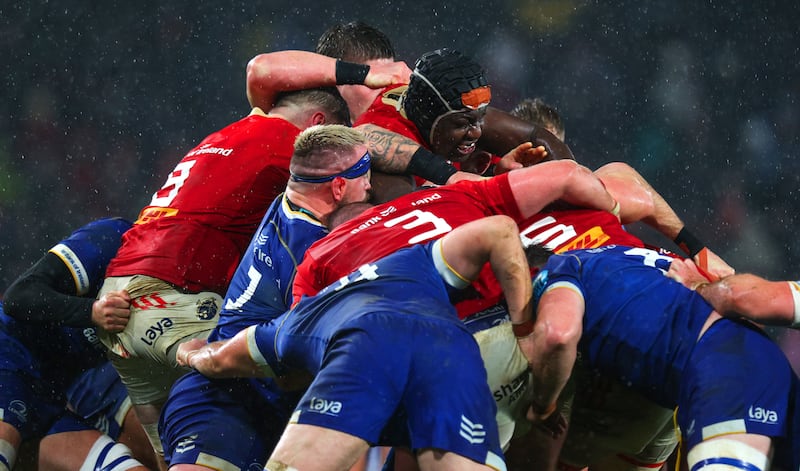The sign said: “Underwater Rugby played here every Sunday night.”
So a few Sundays ago I just had to take a look. Which proved harder than I had anticipated. The game was being played at the bottom of a pool. So I pulled on my goggles, inhaled and stuck my melon under the surface of 2.3m-deep diving pool.
At least no one was blocking my view of the match by going for pints.
Who am I to be critical of other people’s choices of sports? So let me say something positive about watching a game of underwater rugby. No one talked back to the referee.
READ MORE
After the underwater rugby referee had signalled full-time, the two university teams were amicably standing about having a good old bitching session about the laws in their game. Which is an accurate reflection of the state of our game above and below the waterline. Current laws are in dire need of major reform.
It was perhaps a premonition because a few days later World Rugby’s (WR) conclave on the laws emitted not papal white smoke, but something more like a smoke screen.
The media statement contained some gorgeously poetic spin, “ ... the latest phase in the roll-out of the Shape of the Game action plan, a transformative cross-game plan to grow rugby’s audience share. The plan seeks to increase rugby’s accessibility and relevance amongst a broader fanbase by embracing on-field innovation and reimagined presentation of the sport with compelling storytelling.”
Comrades, while that is a cracking chunk of creative writing, the “compelling storytelling” turns out to mean painfully few and mostly bleeding obvious law changes, mixed in with a truckfull of stalling tactics.

To those dedicated, long-suffering administrators at WR who fight for legislative reform and understand that unless our game can change many more laws, with far greater agility, its future is bleak, you have the thanks of the overwhelming majority in our game. Please keep fighting the good fight.
However, an example of the rugby community’s mind-frying frustration at WR’s glacial pace of reform and so-called “reimagining” is best displayed in the decades of delays and yet another “closed trial” for the law that prohibits the defending scrumhalf from moving past the midpoint of the scrum.
This excellent law was introduced into all Australian under-19 rugby as a scrum safety law in the mid 1980s.
The concept was to reduce the time young frontrowers’ necks were under pressure by speeding up the exit of the ball from the scrum. The attacking number eight and scrumhalf were under less pressure and the ball was removed faster.
Unbelievably, four decades after this excellent law was introduced it is still facing more trials than Donald Trump.
Here let us firmly place our cynical hats on our heads.
The modus operandi of the nations who vote on these matters of law and whose international teams may not benefit from the changes is to stifle any legislative reform by using stalling tactics. This involves funneling reforms that are perceived to be disadvantageous to their national team into a labyrinth of working groups and committees, which may then initiate new law trials in competitions across the globe that, once again, will require the results to undergo more evaluation. Rugby as a game comes a distant last behind their often misguided national interest.

This law is firmly in that category, as the Australians who first played under the law whereby the scrumhalf must remain at the midpoint of the scrum are about to turn 60 years of age.
WR’s statement confirms that most key law recommendations remain as law trials. “Unions and competition owners may implement within their own competitions, as ‘closed trials’, the following ...”
- Introduction of the 30-second shot clock for scrum and lineout setting and a maximum of 60 seconds for conversions [a reduction of 30 seconds] aligning with the time permitted for penalty kicks at goal.
- The offside line at the scrum for the non-putting-in scrumhalf will be the middle of the tunnel.
- The ball must be played after the maul has been stopped once, not twice.
- Play on at a lineout if the ball is not thrown straight but only if the lineout is uncontested.
- Revised on- and off-field sanction process. The combination of strong automatic off-field red card sanctions and the ability to replace a red-carded player after 20 minutes.
This means that, despite several of the proposed law changes having been successfully used in Super Rugby, none has been adopted into law.
The statement does say that in November WR will re-examine a number of other laws, including those regarding substitutions and “the impact of fatigue and the number and timing of replacements in the elite game to determine options that might create more space on the field while improving injury rates”.
In other words, the loophole in the laws that currently allows coaches to select benches dominated by behemoth forwards and discriminates against backline players has not been reformed in any way. This is a gross failure of stewardship by WR.

According to several leading doctors who specialise in brain trauma, the forward-dominated benches with increased numbers of fresh giants entering into the game is of grave concern. Yet this major issue of safety has also been kicked into the long grass of a “specialist working group”. An interim measure that would have solved a majority of the problems was to add a simple sentence to the law to state: “Each reserves bench must contain three specialist backs.” But that proved politically too difficult. Again, this is a gross failure in stewardship from WR.
Finally, the WR statement addresses the “fan experience”, saying they wish to “focus on the moments in the game that really engage fans”.
Currently, our game is plagued by the twin scourges of scrum penalties and mauls. Far too many technical scrum penalties are either kicked for points or into touch; and.the following lineout is mauled. This is why benches are packed with forwards and backs are only required to defend.
None of that is “compelling storytelling”, nor is it producing “moments that really engage fans”. That is unless torrents of scrums and mauls float their boat.
Any story that is told with the possibility of 30 forwards dominating a single match will be as compelling as sticking your head underwater and watching a wrestling match at the bottom of a deep pool.


















